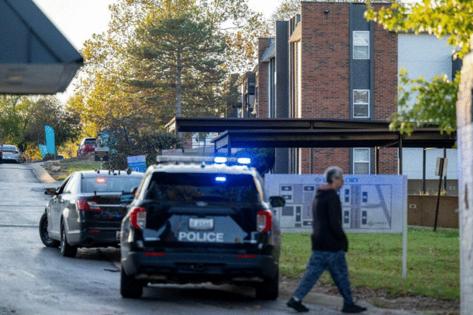After first year of use, Missouri police say they're embracing body cameras
Published in News & Features
KANSAS CITY, Mo. — About a year after Independence police officers started wearing body cameras, the department says that the program has changed the way its staff interacts with residents and collects evidence – and that the cameras are here to stay.
The Independence Police Department received a grant from the United States Department of Justice in September 2023 to pay for 200 body-worn cameras. Until that point, IPD officers were not outfitted with body cameras.
IPD initially told The Star that it hoped to implement the body camera program in January 2024. Last August, the department shared on Facebook that all officers had been issued cameras.
The body cameras used by IPD are made by Axon, an Arizona-based company that developed the TASER stun gun. Deputy Chief Jason Petersen shared an update on the department’s body camera program at a July 28 study session of the Independence City Council.
At the meeting, Petersen echoed IPD’s original messaging around implementing body cameras, saying that the added tool has kept officers accountable to residents while streamlining the collection of evidence for legal proceedings.
“The use of a bodycam can increase transparency and accountability,” Petersen said. “It helps us create a clear record of interactions.”
The year-old IPD body cameras activate automatically when officers turn on the emergency lights in their cars, use their Tasers or come close to another officer. Petersen said this step has been one of the biggest advantages from the past year of camera-assisted policing.
“We don’t want the officers fumbling with the camera trying to activate it, when they should be taking action that could potentially save a life,” Petersen said.
IPD’s policy also mandates that officers wear body cameras if they’re working off-duty, as a security guard or similar, Petersen said.
Funding body cameras
The initial three-year grant from the Justice Department consisted of a $400,000 award, which Independence Mayor Rory Rowland announced in 2023 that the city would match. However, this grant does not fully cover the city’s contract with Axon, which Petersen said is now a 10-year commitment with a broader scope.
The 2024-2025 Independence city budget included $1.2 million in sales tax revenue dedicated to the first year of the decade-long contract, which also includes tasers, in-car cameras, record management systems and virtual reality training for police officers.
Under the city’s proposed 2025-2026 budget, the cost of the annual Axon contract will be paid by both Public Safety Sales Tax and Use Tax revenues.
“We knew what the costs were from day one,” Petersen said.
At the July 28 meeting, councilmembers appeared unconcerned about the ongoing cost. Some reflected on a cheaper but more limited system IPD used in the 1990s, where reports and evidence were organized exclusively on paper through a color-coding system.
“I hear people say, ‘Well, it didn’t cost this much to run the police force in the past,’” McCandless said. “This police force has nothing to do with the 30-year-old police force, because of the technology and the upgrades and the tools you have at your disposal, which causes its own unique budgetary issues.”
Petersen said Monday that the Axon contract includes equipment replacement and upgrades. The company has already replaced several waterlogged cameras at no additional cost, he said.
The original grant also funded three new positions within IPD dedicated to managing the body cameras and their digital systems. Only one of the new employees is a commissioned police officer.
How the cameras work
The United States Bureau of Justice reported in 2016 that about half of police departments nationwide had deployed body cameras. By 2020, Axon was reporting that nearly 80% of police officers nationwide worked in a department that used body cameras.
The Independence City Council had previously tried – and failed – to approve funding for body cameras in 2021. Meanwhile, Kansas City police officers began using body cameras that year, with the Jackson County Sheriff’s Office following suit in 2022.
In addition to the body-worn cameras, officers are also using in-car cameras from Axon, with every officer broadcasting four camera angles — three from car cameras and one from their chest. The in-car cameras write over their saved footage every 30 seconds unless activated, Petersen said.
Footage automatically uploads to an Axon-managed database whenever officers get back in the car or place their cameras on a charging dock. Residents who witness crimes via Ring cameras can add their own footage directly to the IPD camera database by scanning a provided QR code.
Officers are also able to send footage directly from the cloud to the Jackson County Prosecutor’s Office or to members of the media who place public records requests, Petersen said. While similarly sized police agencies tend to delete footage after about 30-60 days, particularly at car stops, Petersen said that uploads from IPD bodycams be saved indefinitely to show at future trials.
The availability of body camera footage won’t necessarily expand the types of video that IPD is required to release to the public upon request. The Missouri Senate passed a bill in 2016 adding language about “mobile video recorders” to the state’s open records law. This means that when departments like IPD decline to release full copies of written reports about ongoing investigations, they can decline to release body camera footage on the same grounds.
Under the Missouri Sunshine Law, police departments can refuse to release documentation relating to active investigations, which includes video footage. However, any person or entity can ask a judge to order IPD or any Missouri police department to release “closed” footage, according to the Kansas City Police Department after an investigation has concluded.
If this happens, IPD or the department has 10 days to notify the people who appear in the video before its release. They have a chance to object, which can lead to further delays.
When a public record request for video is fulfilled or a video segment is released publicly for other reasons, IPD can redact, package and send the footage as a downloadable link straight from the database.
At Monday’s meeting, city councilmember Bridget McCandless said that video footage captured by IPD officers used to be both less frequent and less reliable.
“We should rest assured that [the bodycams] are going to turn on and be recording when we need them to,” McCandless said. “That didn’t used to be the case.”
Privacy and public record
Privacy has also become a greater concern with the availability of video evidence, Petersen said. State law requires IPD to redact a list of identifying markers - like graphic assaults or the faces of juveniles - from any footage released to the public.
“Privacy considerations are always to the forefront of mind when we talk about introducing cameras to situations where they normally aren’t,” Petersen said. “That’s pretty frequently met with consternation by people who want that information.”
Recordings from body camera footage have also been used to train officers, and show them how their behavior reads to the residents they interact with, Petersen said. During IPD’s presentation to the city council, Petersen showed several clips of officers interacting with residents, including a traffic stop, that were harvested directly from the bodycam footage database.
In one notable instance, IPD opted to release edited portions of body camera footage from a Nov. 7 police shooting that left a mother and baby dead. The video briefing was shared to social media and emailed to multiple reporters without explanation, showing a total of four minutes of footage from the fatal 20-minute interaction.
As officers continue to gain experience with using cameras, the department plans to host even more of its activity through Axon, Petersen said. In about nine months, IPD will become the first police agency in Missouri to use Axon Records, an online database that automatically links incident reports and camera footage based on time, location and incident number.
Officers will eventually write their daily reports entirely within the database, Petersen said.
©2025 The Kansas City Star. Visit at kansascity.com. Distributed by Tribune Content Agency, LLC.







Comments